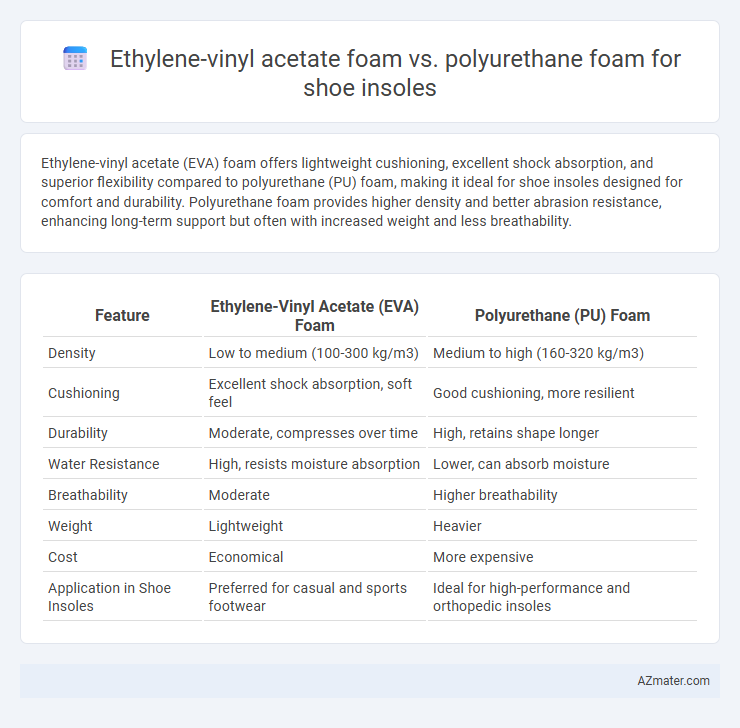Ethylene-vinyl acetate (EVA) foam offers lightweight cushioning, excellent shock absorption, and superior flexibility compared to polyurethane (PU) foam, making it ideal for shoe insoles designed for comfort and durability. Polyurethane foam provides higher density and better abrasion resistance, enhancing long-term support but often with increased weight and less breathability.
Table of Comparison
| Feature | Ethylene-Vinyl Acetate (EVA) Foam | Polyurethane (PU) Foam |
|---|---|---|
| Density | Low to medium (100-300 kg/m3) | Medium to high (160-320 kg/m3) |
| Cushioning | Excellent shock absorption, soft feel | Good cushioning, more resilient |
| Durability | Moderate, compresses over time | High, retains shape longer |
| Water Resistance | High, resists moisture absorption | Lower, can absorb moisture |
| Breathability | Moderate | Higher breathability |
| Weight | Lightweight | Heavier |
| Cost | Economical | More expensive |
| Application in Shoe Insoles | Preferred for casual and sports footwear | Ideal for high-performance and orthopedic insoles |
Introduction to Shoe Insole Materials
Ethylene-vinyl acetate (EVA) foam and polyurethane (PU) foam are two of the most widely used materials in shoe insoles due to their unique cushioning properties and durability. EVA foam offers excellent shock absorption, lightweight comfort, and flexibility, making it ideal for athletic and casual footwear. In contrast, polyurethane foam provides superior resilience and long-lasting support, often preferred for orthotic insoles and high-performance shoes requiring enhanced stability.
What is Ethylene-Vinyl Acetate (EVA) Foam?
Ethylene-Vinyl Acetate (EVA) foam is a lightweight, flexible material widely used in shoe insoles due to its excellent cushioning and shock absorption properties. Compared to polyurethane foam, EVA offers superior resilience and durability, making it ideal for high-impact activities and prolonged wear. Its closed-cell structure provides enhanced water resistance and breathability, ensuring comfort and longevity in footwear applications.
What is Polyurethane (PU) Foam?
Polyurethane (PU) foam is a versatile polymer widely used in shoe insoles for its exceptional cushioning, durability, and moisture-wicking properties. Unlike ethylene-vinyl acetate (EVA) foam, PU foam offers superior resilience and support, making it ideal for high-impact activities and prolonged wear. Its open-cell structure enhances breathability and comfort, providing effective shock absorption and long-lasting performance in footwear applications.
Comfort and Cushioning Comparison
Ethylene-vinyl acetate (EVA) foam offers superior lightweight cushioning and excellent shock absorption, making it ideal for shoe insoles prioritizing all-day comfort and flexibility. Polyurethane (PU) foam provides higher durability and greater firmness, delivering long-lasting support and enhanced impact resistance for active wearers. EVA foam typically excels in breathability and moisture resistance, while PU foam outperforms in maintaining shape and structural integrity under prolonged stress.
Durability and Longevity
Ethylene-vinyl acetate (EVA) foam offers superior durability and maintains cushioning performance over time, making it ideal for shoe insoles requiring long-lasting support. Polyurethane foam tends to compress and degrade more quickly under constant pressure, leading to reduced resilience and shorter lifespan. EVA foam's resistance to cracking and wear ensures prolonged comfort and structural integrity in footwear applications.
Weight and Flexibility
Ethylene-vinyl acetate (EVA) foam offers lightweight cushioning with excellent flexibility, making it ideal for shoe insoles requiring agility and comfort. In contrast, polyurethane (PU) foam tends to be denser and heavier but provides superior durability and resilience under prolonged pressure. EVA foam's lower density contributes to enhanced shock absorption and energy return, while PU foam's structural integrity supports long-term wear without significant deformation.
Breathability and Moisture Management
Ethylene-vinyl acetate (EVA) foam excels in breathability and moisture management due to its open-cell structure, which allows better air circulation and quick moisture evaporation, enhancing comfort during prolonged wear. Polyurethane foam, while offering superior cushioning and durability, tends to retain moisture because of its denser composition, potentially leading to reduced breathability and increased sweat accumulation inside the shoe. Choosing EVA foam for shoe insoles prioritizes breathability and moisture-wicking properties, making it ideal for active users seeking a drier, cooler foot environment.
Cost and Production Efficiency
Ethylene-vinyl acetate (EVA) foam offers a lower material cost and faster molding cycle compared to polyurethane (PU) foam, making it more cost-effective for mass production of shoe insoles. EVA's lightweight nature and ease of processing reduce labor and energy expenses during manufacturing. Polyurethane foam, while providing superior cushioning and durability, involves longer curing times and higher raw material costs, impacting overall production efficiency.
Sustainability and Environmental Impact
Ethylene-vinyl acetate (EVA) foam offers a more sustainable option for shoe insoles due to its lower energy consumption during production and enhanced recyclability compared to polyurethane foam. Polyurethane foam, while providing excellent cushioning and durability, often involves toxic chemicals and poses greater challenges for biodegradation, resulting in a higher environmental footprint. Choosing EVA foam supports reduced carbon emissions and minimizes landfill waste, aligning better with eco-friendly footwear manufacturing practices.
Which Shoe Insole Foam is Best for You?
Ethylene-vinyl acetate (EVA) foam offers lightweight cushioning, excellent flexibility, and good shock absorption, making it ideal for everyday shoe insoles focused on comfort and durability. Polyurethane (PU) foam provides superior resilience, greater support, and higher density, benefiting those requiring enhanced arch support and long-lasting wear under high-performance conditions. Choosing the best shoe insole foam depends on your activity level, foot support needs, and desired balance between softness and structural integrity.

Infographic: Ethylene-vinyl acetate foam vs Polyurethane foam for Shoe Insole
 azmater.com
azmater.com